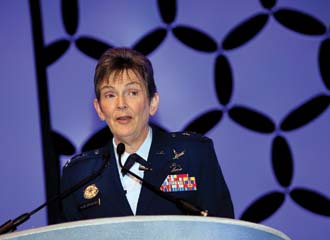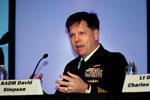When Budgets Go Lean, Military Communications Adapt
 |
Lt. Gen. Ellen Pawlikowski, USAF, commander, Space and Missile Systems Center, addresses the audience at MILCOM 2011. |
In the coming decade, the mantra of doing more without more could become one of the defining hallmarks of military communications—not only for the United States, but also among the nation’s coalition partners and allies.
That sobering reality underscored many of the speeches and panel discussions at MILCOM 2011, held at the Baltimore, Maryland, Convention Center, and co-sponsored by AFCEA International, the IEEE Communications Society and Boeing.
The reality of drastically reduced defense budgets, combined with the rapid pace of technological development, could give warfighters a tactical radio system in the future that has more in common with consumer smartphones than equipment that has traditionally been used on the battlefield.
Don Woodbury, the director of the Strategic Technology Office at the Defense Advanced Projects Agency (DARPA), told a panel on defense buying power and research and development that his group has been turning its research and development prowess to projects such as the Wireless Network After Next (WNAN). With budget constraints in mind, Woodbury said that in this case, DARPA has striven to combine technology with affordability.
Comparing development and implementation of consumer smartphone technology versus that in military communications, Woodbury said, “I think it’s pretty wonderful what’s happening in the commercial world. I really enjoy my smartphone, and every two years, I want a new one not because I’ve worn out the last one, but because I want the new capabilities embedded in the new device.” At the same time, he related that military communications is not fielding new technology with state-of-the-art capabilities for the warfighter at the same rate, in part because the military tends to hang on to communications gear for years at a time.
 |
Lt. Gen. Rhett A. Hernandez, USA, commanding general, U.S. Army Cyber Command/2nd Army, describes the ubiquity of cyberspace in military operations. |
The goal, he said, is to bring to the development of next-generation tactical radios both the business model of consumer smartphones—that is, throw it away after two years and issue a new one—and the technology refresh of those devices. The newest iPhones, for example, have improved cameras.
The ultimate goal, Woodbury allowed, would be interoperable tactical radios that cost about $599 each, using commercial components and standards, and modified to meet military security and field requirements.
In a similar vein, scarce resources mean that change is in store for the constellation of satellites that are the backbone of U.S. military communications.
Lt. Gen. Ellen Pawlikowski, USAF, commander of the Space and Missile Systems Center, foresees a future where reduced budgets will force the military to change how satellites are developed and put into space. She gave an example suggesting that a smaller communications satellite, with a more streamlined list of capabilities, may “catch a ride” with commercial satellites some day.
The general also described a need to develop a common ground control infrastructure for running military communications satellites, declaring that the days of custom-programmed and configured ground systems are over. She believes the same must hold true for developing mission plans for satellites and noted that she thinks it may be time to look at shorter development periods.
It is possible to procure military communications satellites from the commercial market successfully, Gen. Pawlikowski pointed out. She referred to a $1.1 billion agreement her organization signed with Boeing for a next-generation, high-capacity Wideband Global SATCOM system. She praised the contract, signed this past September, for its “savings and awesome capability for an awesome price.”
Elsewhere, at a time when U.S. forces are preparing to leave Iraq, many in the military communications field are giving thought to what they and their colleagues have learned from nearly a decade of operations there and in other locales.
The primary lesson emerging from operations in Afghanistan, Iraq, the aftermath of the Japanese tsunami/earthquake and other operations is that no two network configurations are the same.
Maj. Gen. Randolph Strong, USA, commanding general of the U.S. Army Communications-Electronics Command, told a panel on joint interagency multinational tactical networking that the Afghanistan Mission Network
 |
Rear Adm. David Simpson, USN, |
Gen. Strong allowed that military communications experts continue to learn lessons from the process of making not only the separate networks of U.S. military forces work together, but also exchanging important information with coalition partners. He said a working group continues to refine the operation of the AMN.
The general credited the “collapsing of the traditional acquisition process” in helping to bring innovative and flexible solutions to the warfighter in shorter time frames.
Adm. Simpson emphasized that it is vital to work with combatant commanders at the earliest possible stages to set goals for field network operations. In Libya, for example, the battlefield information systems network sufficed for NATO coalition command and control.
In the Pacific, the need to coordinate with nongovernmental organizations in the Japanese relief effort focused on the use of the All Partners Access Network, an unclassified, non-dot-mil network providing interoperability and connectivity among partners over a common platform.
 |
Maj. Gen. Randolph Strong, USA, commanding general, U.S. Army Communications-Electronics Command (far left), leads a panel discussion on joint interagency multinational tactical networking with (left to right), Rear Adm. David Simpson, USN, vice director, Defense Information Systems Agency (DISA); Lt. Gen. Charles Davis, USAF, commander, Electronic Systems Center; Gary Blohm, director, Army Architecture Integration Center (AAIC), Office of the Chief Information Officer/G-6; and Brigadier Andy Bristow, chief of staff, United Kingdom National Contingent, Afghanistan. |
How the growing importance of cybersecurity will change the way the Army manages its communications resources is another area of concern. By the year 2020, according to Lt. Gen. Rhett A. Hernandez, USA, head of the Army’s Cyber Command, the threats from both nation-states and other unknown actors will necessitate that the Army truly be an integrated cyberforce.
The general said he sees a day when the Army’s cyber warriors are integrated within organizations and staffs throughout the ranks, and when the “full range of cyberspace operations will be routine and pervasive” in both combat and non-combat operations.
Discussing his wish list for industry representatives, Gen. Hernandez said he is looking for hardware and applications that can provide shared situational awareness in a common operating picture; rapid and accurate attribution and forensic capability to help with trusted identities; rapid tool development to give cyber operators the ability to develop resources on the fly; and clearly defined and easily monitored metrics to help measure operational success.




Comments